Sanremo cinemas
The Chiarlie Cinema Theatre
In Cesare da Prato's "Guide to Sanremo" we read...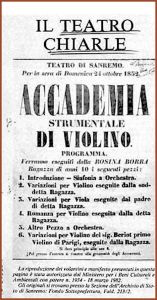 "...lived in Sanremo at the end of the 18th century, the abbot Gio Andrea Chiarle, who loved theatrical representations and, since the Curia forbade him to go around to the theatres, since at that time there was not even one in Sanremo, he thought to have it in his own house, in order to have it at his ease (1787)".
"...lived in Sanremo at the end of the 18th century, the abbot Gio Andrea Chiarle, who loved theatrical representations and, since the Curia forbade him to go around to the theatres, since at that time there was not even one in Sanremo, he thought to have it in his own house, in order to have it at his ease (1787)".
At the time, the theatre was located outside the city centre, near the sea, at the end of what is now Via Gaudio, more or less next to the current church of the Marina.
Of modest proportions, made of wood, it had a circular shape and consisted of an audience, 26 boxes and a gallery. It was one of the main venues for theatrical and opera performances in Sanremo before the first large city theatre was built in the second half of the 19th century.
There were not many companies operating there, but nevertheless the Bishop of Albenga, Giustiniani, put it on trial in 1789, accusing it, among other things, of "practising gambling there"!
Disgusted and disappointed, Chiarle decided to demolish his creation, but was stopped by the Administration, which took him under its protection,
Over the years, the theatre has performed prose, operettas and operas, as well as amateur and student carnival shows.
The founder died around 1820.
Over the years, depending on the political moment, it took on different names: Teatro Chiarle, Théatre de là Ville (during the Napoleonic period), Pubblico Teatro (at the time of the Ligurian Republic); in 1824 it took the name "Teatro di Sanremo".
At the end, until 1877, mainly puppet shows were performed there.
The periodical "Sanremo" of May 20, 1865, advocating the construction of a new, modern theatre, described the Chiarle as follows:
"In order to go to the theatre, one must first of all expose oneself to the fury of the sea and land winds that fight against the door of that old and dilapidated shack, then climb the stairs where there are so many dangers of falling that I would bet it was built by a surgeon rather than an architect"!
(sources: from writings by Andrea Gandolfo, Bruno Monticone and other authors; images from private archive)
The Cinema Sanremese.

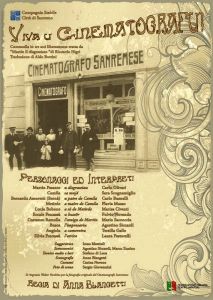 Carlo Vacchino, with his wife Emilia Accatino, began his entrepreneurial activity in the field of entertainment in 1908, taking over the cinema in Via Vittorio Emanuele II, called "The American Cinematograph", renaming it "Cinematografo Sanremese", the first cinematograph in the city which had been inaugurated only two years earlier.
Carlo Vacchino, with his wife Emilia Accatino, began his entrepreneurial activity in the field of entertainment in 1908, taking over the cinema in Via Vittorio Emanuele II, called "The American Cinematograph", renaming it "Cinematografo Sanremese", the first cinematograph in the city which had been inaugurated only two years earlier.
Located on the ground floor, the premises had two hundred seats, a large waiting room, a convenient entrance and a luminous window, where programmes supplied exclusively by the Pathé Consortium were displayed.
For the film business, Carlo collaborated with film distributor Stefano Pittaluga, an enlightened Ligurian film pioneer.
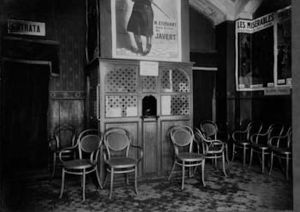 Personal testimony:
Personal testimony:
".......Ed here is the wide entrance of the old Cinema Sanremese where Carlo Vacchino, Carla and Walter's grandfather, coming from Genoa, started his activity in Sanremo as manager of theatre and cinema shows.
The emergency exits of the long and narrow projection room overlooked, as it still does today, Via Volturno and, more than once, when we were young, we used to sneak quickly through these exits into the room crammed like an egg, eluding the even careful surveillance of old Liberato, when between one show and another he would open them to air the room, when the air conditioning systems were still to come.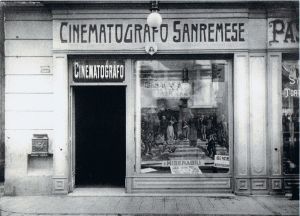 We were, however, of modest pretensions and went to occupy, when we found them, the first rows of the third seats, right under the screen and we got a stiff neck with our heads turned upwards to follow the sequences of the film, sometimes still silent, accompanied only by the notes of the pianist who, with skill and timing, synchronised them with the images, which to us appeared distorted and stretched out of proportion, from bottom to top, as happens to our figure when it is reflected in deforming mirrors.
We were, however, of modest pretensions and went to occupy, when we found them, the first rows of the third seats, right under the screen and we got a stiff neck with our heads turned upwards to follow the sequences of the film, sometimes still silent, accompanied only by the notes of the pianist who, with skill and timing, synchronised them with the images, which to us appeared distorted and stretched out of proportion, from bottom to top, as happens to our figure when it is reflected in deforming mirrors. 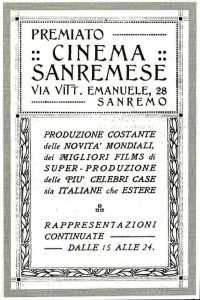 We could also have sneaked into the first seats, characterised by folding armchairs covered in red velvet, but we were content with the "thirds", also because, when the lights came on between one time and another, our group of "Portuguese" (scroungers) would have been immediately identified by the ushers, who were able, with a glance, to assign each spectator in the room the right place.
We could also have sneaked into the first seats, characterised by folding armchairs covered in red velvet, but we were content with the "thirds", also because, when the lights came on between one time and another, our group of "Portuguese" (scroungers) would have been immediately identified by the ushers, who were able, with a glance, to assign each spectator in the room the right place.
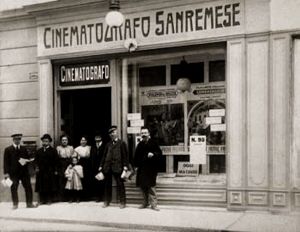 It was then a heroic era for the cinema, when television was still at the design stage and the noble art of the Lumiére brothers had nothing to fear from it.
It was then a heroic era for the cinema, when television was still at the design stage and the noble art of the Lumiére brothers had nothing to fear from it.
Being able to get into one of the few theatres available at that time, especially on holidays, was a rather difficult task and, if this happened, most of the time you had to be content to follow the events of the film for almost the entire time standing up, so crowded was the crowd.
Let's not talk about when dramas such as Ben Hur, the first of the series starring the charming Ramon Navarro, the White Nun, the Sign of the Cross, Les Miserables or, in more recent times, giants such as Gone with the Wind were shown.
The real "fiction", so much vaunted today, was that of that time when, after crying for almost the entire duration of the tear-jerking show, people, especially the fairer sex, would come out pressing a handkerchief over their eyes and, blowing their noses, would exclaim in a voice broken by emotion: "What a beautiful film! How much fun I had!!!"
(sources: elaboration from " C'era una volta la Via Vittorio " by Cesare Gentili and from the book "Sanremo e l'Europa, l'Immagine della Città tra Otto e Novecento" edited by Letizia Lodi; ediz. Scalpendi, 2018; images from Private Archive)
Cinema Teatro Centrale
In the climate of general social and economic recovery in the years immediately following the end of the First World War, Sanremo too became the destination of numerous entrepreneurs and businessmen who wanted to make the most of the city's enviable position to relaunch its tourist image and bring it back to the splendour of the belle époque.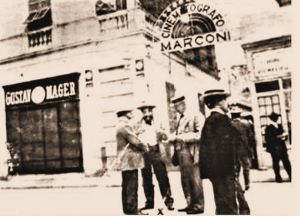 Among them was impresario Aurelio Berardinelli, then owner of a large cinema in Salsomaggiore Terme in the province of Parma, who decided to build a large new theatre and cinema in the very central Via Vittorio Emanuele II (today's Via Matteotti) along the prospect of today's Corso Mombello, on the same land where first the Arena Sisto and then the Parisiana cinema, which later became Marconi and finally Moderno, had been built.
Among them was impresario Aurelio Berardinelli, then owner of a large cinema in Salsomaggiore Terme in the province of Parma, who decided to build a large new theatre and cinema in the very central Via Vittorio Emanuele II (today's Via Matteotti) along the prospect of today's Corso Mombello, on the same land where first the Arena Sisto and then the Parisiana cinema, which later became Marconi and finally Moderno, had been built.
The latter, already owned by the Moraglia family and with its structure still made of wood, had its entrance near Caffè Europèen, open on the Rigolè, as the intersection between today's Via Matteotti and Via Feraldi and today's Corso Mombello was then commonly referred to.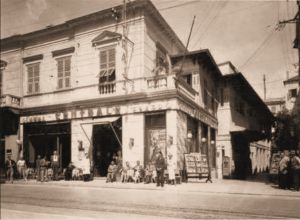 The entrepreneur from Salsomaggiore therefore entrusted the project for the construction of the new building to his fellow citizen architect Guido Tirelli, who in the Emilian city was director of the Municipal Technical Office and chief engineer of the large Belzieri Spa factory. The cement works were entrusted to Ugo Jacazio of Genoa, while the wrought iron was made by the Lombard craftsman Alessandro Mazzucotelli.
The entrepreneur from Salsomaggiore therefore entrusted the project for the construction of the new building to his fellow citizen architect Guido Tirelli, who in the Emilian city was director of the Municipal Technical Office and chief engineer of the large Belzieri Spa factory. The cement works were entrusted to Ugo Jacazio of Genoa, while the wrought iron was made by the Lombard craftsman Alessandro Mazzucotelli.
The official inauguration of the new theatre took place on 20 March 1924. Berardinelli had expressly commissioned the theatre to be used mainly as a cinema, as indeed it was from the very first years, also due to the reduced depth of the stage. And it was precisely for its cinema functions that the Centrale received its first important recognition with the awarding of the Diploma, Grand Prize, Gold Medal and Cross of Honour for Industrial Merit at the First International Exhibition in Rome in 1926.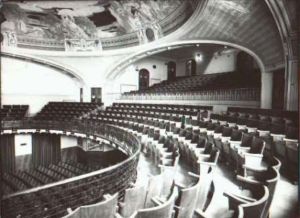 Although it was commissioned for cinema, the Centrale was designed as a real theatre, as is evident from the typical forms of the boccadopera with four proscenium boxes in perfect harmony with the best 19th-century tradition. The horseshoe design of the balconies inserted in the arms of the Latin cross on which the building's plan is developed is also of purely classical inspiration.
Although it was commissioned for cinema, the Centrale was designed as a real theatre, as is evident from the typical forms of the boccadopera with four proscenium boxes in perfect harmony with the best 19th-century tradition. The horseshoe design of the balconies inserted in the arms of the Latin cross on which the building's plan is developed is also of purely classical inspiration.
Within the general decorative scheme of the theatre, in tune with the canons of the most genuine Italian theatrical tradition, the great fresco on the annular band of the dome is particularly noteworthy, depicting Sanremo Trionfante surrounded by centaurs and nymphs in flight amidst lights, solar images and marine scenes, the work of the Tuscan artist Galileo Chini (1873-1956), one of the greatest and most famous interpreters of Italian figurative art in the first two decades of the last century.
At the centre of the dome, a trapdoor opened mechanically at the end of each performance, while between the trapdoor and the graceful figures frescoed by Chini, the motto is engraved: "Canto di Luce l'inesprimibil sogno in Verità tramuta" (Song of Light the inexpressible dream is transformed into Truth), whose obscure meaning has been reasonably interpreted as the truth of the sky opening up after the cinematographic fiction, or dream.
The theatre structure was completed in 1928 with the creation of the large Art Deco façade designed by Pietro Agosti, the engineer and then mayor of Sanremo, who proved to have learned the dictates of the new artistic current imposed by the Exhibition of Decorative and Industrial Arts in Paris in 1925.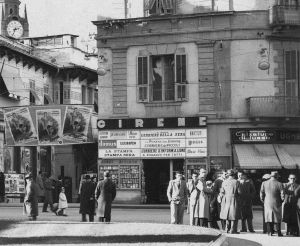 In the first years of activity, the public could access the cinema through a large atrium on the ground floor of the building, located to the left of the courtyard where the current entrance opens. After descending a few steps, one reached the entrance to the stalls, flanked on the left by the staircase used to climb up to the boxes and the two tiers of galleries, while the right side, overlooking the courtyard, housed only the exits.
In the first years of activity, the public could access the cinema through a large atrium on the ground floor of the building, located to the left of the courtyard where the current entrance opens. After descending a few steps, one reached the entrance to the stalls, flanked on the left by the staircase used to climb up to the boxes and the two tiers of galleries, while the right side, overlooking the courtyard, housed only the exits.
Next to the cinema, with which it was in communication but with a separate entrance and foyer (and still well preserved and visible, even if incorporated in the shop at number 97 Via Matteotti), the Tabarin Florida was built and opened to the public in 1929. This was a small nightclub where people could watch variety shows and whose name derives from that of a seventeenth-century French comedian, called Tabar after the type of cloak he wore.
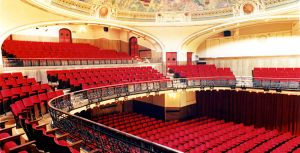 Particularly refined are the small stage enclosed by two naked maidens, supple caryatids made of polychrome painted papier-mâché, the walls and ceiling richly decorated with Art Deco motifs with a Triumph of Cupid in the centre, while the wall opposite the stage features a large painting of Spring, a tribute to Sanremo's mild climate, the main reason for the city's tourist success, by Paolo Rusconi, who was also the author of all the other paintings and decorations in the hall.
Particularly refined are the small stage enclosed by two naked maidens, supple caryatids made of polychrome painted papier-mâché, the walls and ceiling richly decorated with Art Deco motifs with a Triumph of Cupid in the centre, while the wall opposite the stage features a large painting of Spring, a tribute to Sanremo's mild climate, the main reason for the city's tourist success, by Paolo Rusconi, who was also the author of all the other paintings and decorations in the hall.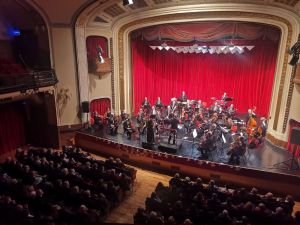 A few years after its inauguration, however, the management of the Centrale by the Salsese entrepreneur Berardinelli was already in crisis, partly due to the fact that the cinema-theatre still lacked a sound system, In the end, Berardinelli managed to avoid bankruptcy only by selling the building in 1933 to the Vacchino company, then managed by Mrs Emilia, widow of the founder Carlo, and her young son Aristide, who were destined to play a major role in the history of Sanremo's theatre and cinema industry. In the years leading up to the Second World War, the entrance and lobby in front of what is now Via Matteotti were converted into premises reserved for commercial activities.
A few years after its inauguration, however, the management of the Centrale by the Salsese entrepreneur Berardinelli was already in crisis, partly due to the fact that the cinema-theatre still lacked a sound system, In the end, Berardinelli managed to avoid bankruptcy only by selling the building in 1933 to the Vacchino company, then managed by Mrs Emilia, widow of the founder Carlo, and her young son Aristide, who were destined to play a major role in the history of Sanremo's theatre and cinema industry. In the years leading up to the Second World War, the entrance and lobby in front of what is now Via Matteotti were converted into premises reserved for commercial activities.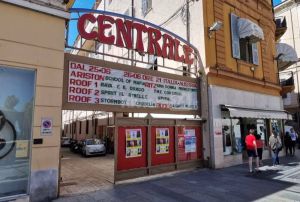 Between June and September 1987 the whole complex of the Centrale was finally subjected to a series of interventions aimed at a careful and scrupulous restoration of the structure through its homologation with the most recent safety regulations and the most modern technical equipment. In particular, the theatre hall, enlarged after the war, was restored to its original dimensions and characteristics, obtaining in the spaces thus obtained a new room used as a video-club.
Between June and September 1987 the whole complex of the Centrale was finally subjected to a series of interventions aimed at a careful and scrupulous restoration of the structure through its homologation with the most recent safety regulations and the most modern technical equipment. In particular, the theatre hall, enlarged after the war, was restored to its original dimensions and characteristics, obtaining in the spaces thus obtained a new room used as a video-club.
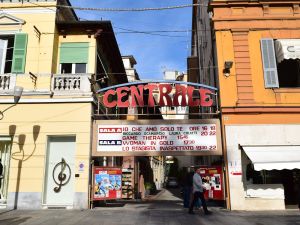 During these interventions, the old Tabarin Florida, which had been downgraded to a warehouse after becoming a billiards room in the early 1950s, was brought back to life. Thanks to the careful restoration, the room has regained its old Art Nouveau splendour, becoming a small cinema and theatre for about one hundred seats, which has taken on the historical name of Cinema Tabarin.
During these interventions, the old Tabarin Florida, which had been downgraded to a warehouse after becoming a billiards room in the early 1950s, was brought back to life. Thanks to the careful restoration, the room has regained its old Art Nouveau splendour, becoming a small cinema and theatre for about one hundred seats, which has taken on the historical name of Cinema Tabarin.
In front of the main entrance of the Centrale there is a flower-bed with the statue of Ondina, created by sculptor Vincenzo Pasquali, like its famous sister Primavera in the Imperatrice promenade, and already located for a long time in the gardens in front of the Morgana beach.
(source: texts by AndreaGandolfo; images from private archive and WEB)




